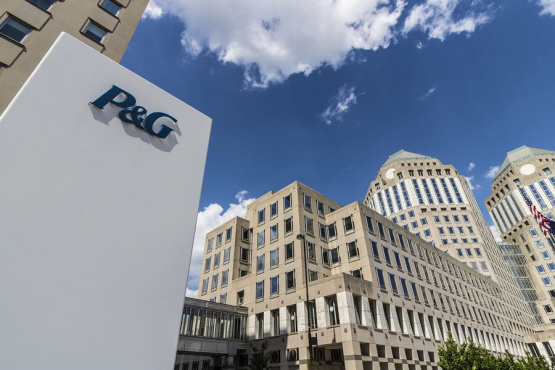P&G Witnesses Balanced Risk-Reward: Stock Up 31.2% in a Year

The Procter & Gamble Company
PG, popularly known as P&G, displayed immense strength on the
back of initiatives that include product improvement, packaging
& marketing, and productivity and cost savings. These efforts
have not only aided quarterly outcome but also boosted share price,
with gains of 31.2% recorded in the past year. This performance is
well ahead of the industry’s growth of 15.6% in the same
period.
However, like all consumer goods companies, P&G is suffering
from a graph of strained margins due to higher costs, with
continued impacts of foreign currency rates, which cannot be
ignored. With these headwinds likely to continue through the rest
of the fiscal year, let’s see how this branded consumer products
company will retain stock momentum.
Factors Likely to Aid Stock Performance
We believe the aforementioned initiatives should provide enough
support to maintain the momentum in the Procter & Gamble stock.
Going into details, the company remains focused on productivity and
cost-saving plans to boost margins, thereby lifting the profit
level. Its continued investment in business alongside efforts to
offset macro cost headwinds and balance top and bottom-line growth
underscores productivity efforts.
With cost savings and efficiency improvements across all facets of
business, the company is nearing the mid-point of the second
five-year (fiscal 2017-2021) cost-saving target of $10 billion. The
second five-year restructuring plan targets $7 billion in COGS
savings ($4.5 billion from raw and packaging materials, $1.5
billion in manufacturing savings, and $1 billion from
transportation/warehousing/other); $2 billion of marketing cost
reductions; $1.5 billion of trade spending savings (10%
efficiency); and $1-$2 billion of additional overhead
reductions.
Additionally, the company’s efforts to enhance the product
portfolio by acquiring complementary businesses have been key
highlights. Some of its recent acquisitions include the beauty
brand — First Aid Beauty — for $250 million in July 2018, and the
consumer health business of Germany-based Merck KGaA (for $4
billion) and Walker & Company Brands in December 2018.
Simultaneously, the company divested several assets over the years
as part of the portfolio-reshaping plan. The most prominent among
these is the sale of four product categories, comprising 41 beauty
brands, to Coty in 2016. Other divestitures include P&G’s
snacks unit — Pringles; the global bleach business, the Braun
household appliances business, pet care businesses in America, Asia
and Europe; and the Duracell batteries business.
These actions have been the key to the company’s robust quarterly
performance over the years, having recorded earnings beat for 15
straight quarters and sales beat in five of the last six quarters.
Backed by these initiatives, it anticipates continued improvement
in organic sales in the years ahead. As a result, the company
raised the upper end of the fiscal 2019 organic sales guidance by
1%. Organic sales are now estimated to increase 2-4%. Further, it
now expects all-in sales to be down 1% to up 1% in fiscal 2019
versus previously mentioned 2% decline to flat.
Factors to Hinder Growth
P&G is no exception to the sluggish margin trends prevailing in
the consumer packaged goods industry. Like most of its peers, the
company’s margins continue to be strained due to higher commodity
and shipment costs as well as increased brand investments. Intense
competition and adverse currency remain other constraints to
margin. Additionally, the company’s significant international
presence exposes it to foreign currency risks, which have been
weighing on performance. Although its cost-saving initiatives are
contributing meaningfully to margin expansion, this is not enough
to negate ongoing headwinds.
While pricing gains slightly cushioned negative margin trends in
second-quarter fiscal 2019, the company expects currency headwinds,
higher business investments, commodity costs and competition to
weigh on margins in the near term. Commodity costs are likely to
impact earnings by nearly $400 million in fiscal 2019 while
trucking costs are anticipated to increase 25% or more from the
last year.
Further, the company’s all-in sales guidance includes currency
impacts of nearly 3-4%. Earnings guidance also includes an adverse
impact of nearly $1.4 billion from foreign currency, and escalated
commodity and transportation expenses. Of this, currency headwinds
on earnings are likely to be about $900 million.
Conclusion
The above discussion clearly shows that Procter & Gamble has
balanced risk-reward, with its progress on efforts to offset
hurdles. Further, the company’s Zacks Rank #3 (Hold) and expected
long-term earnings growth rate of 6.9% speak well of its growth
potential.
Don’t Miss These Better-Ranked Stocks From the Same
Industry
Colgate-Palmolive Co. CL has a long term earnings growth rate of
5.5%. The stock presently carries a Zacks Rank #2 (Buy). You can
see the complete list of today’s Zacks #1 Rank (Strong Buy)
stocks here.
Unilever NV UN, with long-term earnings per share growth rate of
6.5%, currently carries a Zacks Rank #2.
Reckitt Benckiser Group PLC RBGLY, with long-term earnings per
share growth rate of 3.7%, also carries a Zacks Rank #2.
Is Your Investment Advisor Fumbling Your Financial
Future?
See how you can more effectively safeguard your retirement with a
new Special Report, “4 Warning Signs Your Investment Advisor
Might Be Sabotaging Your Financial Future.â€
Click to get it free >>
Want the latest recommendations from Zacks Investment Research?
Today, you can download 7 Best Stocks for the Next 30 Days.
Click to get this free
report
Unilever NV (UN) : Free
Stock Analysis Report
Procter & Gamble
Company (The) (PG) : Free Stock Analysis Report
Reckitt Benckiser Group PLC
(RBGLY) : Free Stock Analysis Report
Colgate-Palmolive Company
(CL) : Free Stock Analysis Report
To read this article on
Zacks.com click here.